In this article, we will know specific detailed insights and facts of what is a plane mirror reflection.
Plane mirror reflection is a physical optical process that helps form images that are virtual and inverted in nature. The incident and reflected rays that strike and emit from a plane mirror satisfy the laws of reflection. It is typically used in everyday chores.
Now to focus on the various characteristics of what is plane mirror reflection.
Plane Mirror: Definition and facts
A plane mirror is one of the essential mirrors used generally in daily routine.

The definition of a plane mirror goes like this: it is a surface with no irregularities. It is flat on which the reflection process occurs to produce a virtual, straight image with an identical distance from the mirror.
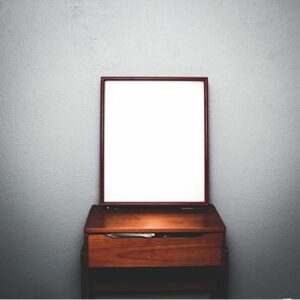
Now to know the meaning of reflection.
Reflection: Meaning
The term reflection in optics refers to the replica of an image and the process that helps to view things.
Reflection is a process of light radiation usually mentioned in the optics part of physics that satisfies the essential laws that help to define the way an image is formed. It is bouncing back of incident light from a reflecting surface.
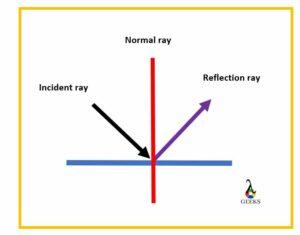
To focus on the aspects and definition of what is plane mirror reflection.
What is plane mirror reflection?
A plane mirror reflection is a physical optic process that helps know how any image is formed on a flat surface used for various purposes.
In a plane mirror reflection, when an incident light ray strikes the flat surface with no irregularities, the reflected right at equal angle bounce back, giving an image that is virtual and straight in position and reflects equal width and height of the images observed.

It was all about plane mirror reflection, now to focus on the other insights of what is plane mirror reflection.
Why do plane mirrors produce regular reflection?
Regular reflection refers to the types of reflection obtained from a surface that contains no irregularities.
The regular reflection is even known widely as specular reflection. It can be also be known as the reflection of the image formed by a plane mirror. We know that plane mirror has no irregularities with a flat surface which is the main characteristic of regular reflection. It is the reason why plane mirrors produce a regular reflection.
To know the insights of how images are produced from a plane mirror reflection.
What happens when reflection occurs in a plane mirror?
When a reflection occurs from any plane mirrors, we get the exact and inverted images of the observed image.
When a pack of light rays falls on any plane mirror at the surface point, the light gets reflected in a perpendicular direction, leading to the formation of the virtual image.
In a plane mirror, it undergoes specular reflection.
Plane mirror reflection diagram
The schematic diagram of how a plane mirror forms an image through regular reflection is shown below,
A plane mirror, in general, consists of a flat and plane in nature. The material of the plane mirror is made up of a reflective surface. The images formed by the ray undergoing reflection are produced behind the mirror’s surface. The diagram shows how the rays get reflected.
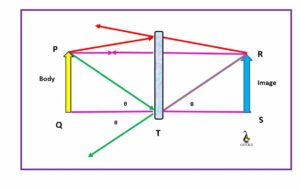
To know about the plane mirror reflection experiment.
Plane mirror reflection experiment
To conduct a plane mirror reflection experiment, we require two plane mirrors and sources of light, a tape, scale, protractor, pencil and any image.
Construction
Take the plane mirror and stick them together using tape such that they are foldable and perpendicular to one another.
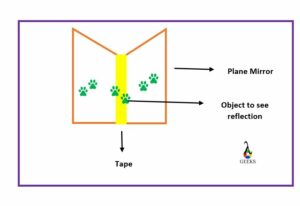
Procedure and experiment
To begin with, when you keep any object between the two mirrors, you will be able to observe the reflection of the image on the mirrors.
You can use a scale and point the space distance, and by using a protractor, you can measure the angle of incident and reflected rays. Even you can use any LED laser light to observe the nature of the incident and reflected rays.
We have measured three pairs of lines of rays, and these are normal to one another. The incident and reflection are depicted through different lines.
At a point considered ‘x’, the incident light is 1 and reflected is 1I; similarly, at a point ‘y’, the incident light is 2 and reflected is 2I, and it continues at point z.
At the points x, y, and z, the circular wavefronts are formed, and thus we can write it down as
xz = by leading to the formation of an isosceles triangle, and the obtained angles will be θ1 = θ2.
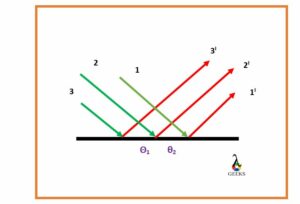
Here the angles are respectively denoted as angles of incidence and reflection.
From this, we can say that the angle of incidence will be equal to the angle of reflection; it also satisfies laws of reflection.
Plane mirror reflection simulation
The plane mirror reflection simulation referred to the process of how many incidents and reflected rays come together in the formation of a virtual, erect image.
When any light source falls on a flat reflecting surface, several reflected rays typically bounce from the point of the incidence at various angles.
It gets stimulated together to produce a good, clear image at an equal distance from the mirror with the same height and width the object observed.
To know the facts of an image formed by a plane mirror reflection.
Image Formed by the Plane Mirror
All the reflective process undergoes specific phenomenon and produces images according to the characteristics and nature of the mirror.
The images produced by the plane mirror reflection will have the following properties,
- Virtual.
- Straight or upright or erect.
- Replica of the image
- will invert the image on both left and right sides.
There are many more aspects of plane mirror reflection. To know more, click below;
Frequently Asked Questions |FAQs around plane mirror reflection
What do you mean by the definition of plane mirror reflection?
The simple definition of plane mirror reflection tells about the nature of the surface that causes reflection.
A plane mirror, in general, is defined as a flat surface of a mirror, on which when light rays fall and are reflected, it produces an image of a particular object in erect and visual form. The surfaces of the plane mirror on both sides will be different.
What type of image is formed on a plane mirror?
The plane mirror is a type of mirror that is used widely in daily routine life.
The image formed by any plane mirror that we use to see our reflection is virtual and is formed at the same distance from the object to mirror distance and will of the same size. The image will be upright and reverse to the original image.
What are the different applications of plane mirrors used?
The mirror used in our households is usually constructed using plane mirrors to replicate the images we wish to observe. The different applications are mentioned below,
- They are used as beauty mirrors.
- They are even used as a combination with another lens in constructing the instrument called periscope that is found in underwater ships called submarines to look at obstacles.
- They are similarly used in the construction of kaleidoscope that gives the unique art pattern when observed.
- Many instruments that help in finding different science attributes use plane mirrors.
- At jewellery shops, dressing mirrors etc.
What are the essential properties of any plane mirror?
Any mirror will possess some characteristics that will be important to produce an image, the essential properties possessed by any plane mirror are as follows;
- The image formed on any plane mirror will be a replica of the image, i.e., virtual.
- The image formed will be somewhat inverted that is left portion appears on the right and vice versa.
- The distance at which the image formed on the mirror will be equal to the image seen from the image.
- The image formed shows the exact width and height of the object observed.
- The image will be straight or erect.
- The images on a plane mirror due to reflection will usually occur behind the mirror.
Does plane mirrors reflection produce erect images?
Plane mirrors are mainly constructed to produce straight or erect images.
The image reflected on a plane mirror will be upright, the incident and reflected ray will be at the same distance that leads to erect images. The image reflected on a plane mirror will be upright.
What are the main disadvantages of plane mirror reflection?
The main disadvantages that occur due to the plane mirror reflection are given below,
- The construction process will be costly.
- It will be delicate and fragile.
- If there is a very high temperature, there is a chance of melting.
- During fog and temperature variation, it may lead to minor imperfection in images.
What does the term plane mirror reflection mean?
A reflection plane is usually a surface on which the process of reflection takes place.
When a pack of light rays falls on a specific surface, radiation light rays strike the plane and get reflected normal. The incident and reflection propagation direction will always be perpendicular to the reflecting surface.
What do you mean by reflection on a Plane Mirror?
Reflection on a plane mirror or reflection by plane mirror refers to how an image is formed on a plane mirror through reflection.
- When a particular beam of light radiation is allowed to the incident on a flat or plane mirror, it undergoes reflection perpendicularly from the surface. These beams satisfy the laws of reflection, and both the incident and reflection ray angles will be similar.
- Therefore, we can conclude that the process of getting a virtual, straight and equal image is known as a reflection on a plane mirror.
Does reflection from a plane surface satisfy laws of reflection?
Without satisfying the laws of reflection, the plane mirror reflection is not possible.
The primary law of reflection tells that the ray of the incident and reflected angles from any reflecting surface will be equal and perpendicular. It is generally denoted by the represented shown below,
∠I =∠r
Therefore, we can tell that plane mirror reflection will always satisfy the laws of reflection.
Does the two laws of reflection the same for plane mirror reflection?
The laws of reflection will always be the same for all the kinds of reflection that occurs.
Both the laws of reflection state that the incident, reflected and ordinary ray, will constantly be on the same surface. The subsequent law says that both incident and reflection angles will be equal irrespective of other conditions. These laws will be the same in the case of plane mirror reflection.
Also Read:
- Why do we see a flash of blue or green just before the sun sets
- Neutral equilibrium examples
- Hydrophilic examples
- Constructive and destructive interference
- Parabolic mirrors
- How can a physical change occur
- Overview differential amplifier bridge amplifier
- Dew point and bubble point
- Anatomy of the human ear
- Do a hammer drill spin

I am Raghavi Acharya, I have completed my post-graduation in physics with a specialization in the field of condensed matter physics. I have always considered Physics to be a captivating area of study and I enjoy exploring the various fields of this subject. In my free time, I engage myself in digital art. My articles are aimed towards delivering the concepts of physics in a very simplified manner to the readers.